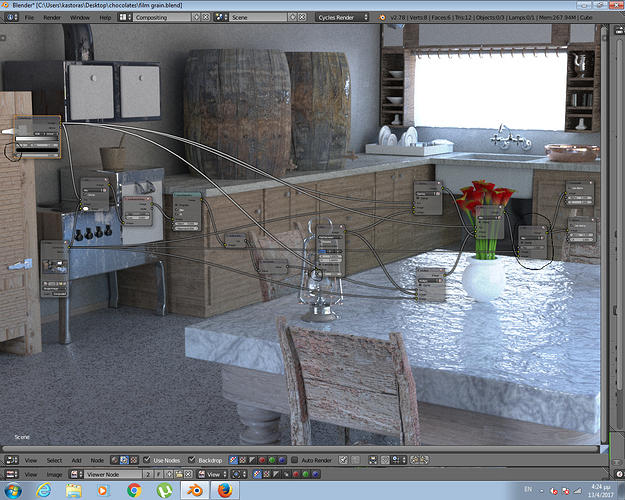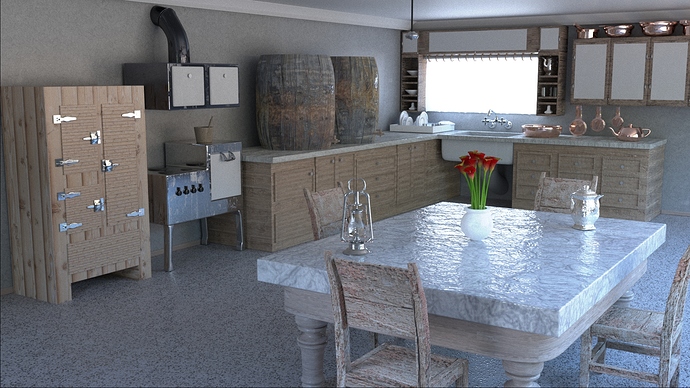Hey guys, last days I am watching some tutorials about film grain. Most of them are using ps, but I want to create it in blender. My point is that i want to produce nice grain in blender but not use a texture for it. The reason is, watched that as using a 35mm sensor to a 16mm grain becomes much more evident. What I was thinking is mixing the main image with a B&W version of it and using jitter in LS. The results were really bad. Any idea?
Any reason why you don’t want to use textures? I guess you mean procedural textures here, not actual captured noise/grain recordings?
I think that if I use textures to produce this effect, I will have to adjust it in every image or video I will have to compose or from adjusting from 35mm to 16mm or different cameras maybe. Don’t know if I am right. I was thinking of making a node setup like this guy, who did it with vignette https://www.youtube.com/watch?v=7ySp0noBz_w and not to have to make big changes every time. I am a starter yet, so what do you think? Can this be achieved or am occupied with no reason?
Adjusting from one sensor size to another is not that much work, it is basically one parameter in some node when noise profile itself will be identical. I would try to make it work first and then automate it if really necessary.
If you are trying to simulate film grain, search for closeup grain samples in google and mimic them with procedural textures. Also look how grain is distributed over pixels (size of grain elements relative to size of scanned raster) and relative to luminance, and what is the size and relative proportion of grain in each image channel.
grain is also related to color so you might want to look at effects on size and shape based on color separation. Also there are different film emulsion layers for the various color components, they vary depending on th nature of the film stock. Faster = noisier, so darker = noisier for example.
I find it a little confusing how you mention film grain an sensors. You mean like scanning a film and referring to the scanners sensor?
In this case the grain really should not depend much on the sensor (resolution aside) but only on the film emulsion and processing.
Same goes with the actual filming. Grain should only change when the emulsion or its processing changes which is unlikely (not impossible) to happen in one scene.
You can emulate this to a certain extent with a captured film grain and if you want it to look more like a push processing or higher ISO film you can scale it up a little and add more to the mix. Should be very possible to link this to your cameras exposure controls to have it adjusting automatically.
I can hardy think of a easier to maintain way once you got that linking.
Edit: changing the film format would change the grain size relative to the captured image of course but you would not change that too often in the same shoot.
We can also call it filmback, does not matter. Personally I find speaking of sensor size more logical when dealing with virtual digital cameras. What matters is that we try to emulate an organic irregular grain pattern on a regular image raster and to get the feeling of how it looks when it is “baked” into regular raster we look at film scans, not actual film strip.
What I was implying in my post and what you already captured in your edit was that when we change the sensor/filmback size we change the grain size relative to raster size. A 16mm film scanned at 2K is grainier than a 35mm film at 2K not because it is somehow more robust but percisely because we scale the grain more relative to scanning raster. And so when we switch from 35mm filmback to 16mm we also need to simulate the relative grain size when render resolution does not change.
This is until now. I will work more on it on weekend because i am working right now. If you have any ideas please post.
The term, “film grain,” is often a colloquial expression for all of the known characteristics of “film stock.”
For instance, I have a copy of the Raiders of the Lost Ark trilogy that is beautifully color-corrected, and, yes, I do respect and appreciate the technical skills of the engineers who achieved that. But, last summer, I munched popcorn in a parking lot with my sweetie (my wife), outside a movie theater that showed a 35mm print of that same film on the side of their building. This was the way that both of us (koff, koff, these kids today …  …) remember originally seeing it as a kid.
…) remember originally seeing it as a kid.
The film stock had a sharp reddish color-cast and a very compressed range of f-stops. (It might have been Kodacolor®.)
And, furthermore, the costume designers and set-dressers of the day knew this, and accounted for it in their choices of lighting, prop-painting, makeup, and especially costume design. The color was much more compressed, therefore also much more intense, and they worked within this constraint, indeed leveraging it for dramatic effect.
That evening, I watched the film as its designers had anticipated that it would be seen. And, I was reminded, it is very different from my DVD.
If you refer to all characteristics of film stock as grain, it will be very confusing. I can’t recall having heard it used is such broad context, especially when talking about compositing.
For sure, its still really bad and needs more work, but some little progress has been done. Values that work, if you want to try it, is still between 0.100 to 0.300 for first value and all the others between 0-1 that are making the grain somehow blurred. This effect can be shown on shadows and dark colours.
I actually meant it to be “such a broad context,” because it is … especially when “we are no longer actually using ‘film.’” Grain is only one characteristic of the “silver days.” Although “in the silver days,” one never needed to pause to consider “anything but actual silver,” those days are gone now.
The image-capture technologies that we use today have no intrinsic biases – really, no technical limitations at all. But, the technologies that we today may wish to mimic, most-certainly did.
If all you need for your project is a sense of “graininess,” that’s easy … that’s basically noise, and basically nothing more.





